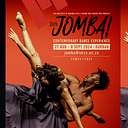Belongings, interconnections and disconnections
By Ngcebo Bhengu
The “JOMBA! on the EDGE” platform for 2022 includes three distinct works by KZN-based artists. The works are all a response to the festival provocation “The (im)possibility of home”.
SAMSARA is choreographed by Pavishen Paideya and is danced by him along with, Cameron Govender, Adarsh Maharaj, Shanay Paideya, Kamara Naidoo, Loriksha Hoodeo, Divaksha Jinabhai, Primeshni Govender. This performance explores South African diasporic Indian culture and identity. South African diasporic Indians are proof that humans are living archives, as they continue with their Indian beliefs, traditions, and culture even though they are dispersed outside their homeland. The work is a mixture of Bharathanatyam (Indian Classical dance) and contemporary dance styles with costumes designed by Paideya that evoke traditional Indian silhouettes.
The performance indicates cultural leanings towards heteronormative gender roles, represented in the choreography when the men enter and the women use their sarees to wipe and clean the floor. Hindustan music scores the dance and provides an under-rhythm to the narrative dance work that offers insights into South African Indian-ness.
Take Me Back Home is choreographed by Sandile Mkhize (in collaboration with Tshidiso Kabulu) and is danced by Mkhize and Kabulu. This performance begins with Tshediso Kabulu entering behind the audience and venturing onto stage, directly questioning the audience about what constitutes manhood. Mkhize walks slowly in the background.
In the work Tshediso Kabulu is presented as effeminate (wearing heels, walking with swagger), and Sandile Mkhize is initially presented as a macho Zulu man (wearing a scotch shirt and old brown blazer — a regular sight in KZN rurals, taking up space in his stance). In the duet, Kabulu imitates Mkhize’s masculine moves, but they don’t quite fit his mannerisms and embodiment. Mkhize forces Kabulu to remove his heels and clothes. These are replaced with big dark brown pants, a scotch shirt and old brown waistcoat. The following duet begins with an initially awkward but increasingly tender hug between the two men. This performance is about self-discovery. The schisms of queerness as “un-African” are gently unpacked as the work unfolds.
HEAD_SPACE, conceived and performed by Tegan Peacock includes collaborators Wayne Reddiar on sound and Hannah Lax as a designer. It is a performance that focuses on the connection between the body and the mind. The body is controlled by the mind/the mind is controlled by the body. The soundscape in this performance is used to highlight the state of mind of Peacock in her performance. Wayne Reddiar creates a soundscape that is in dialogue with Peacock’s choreography and this is triggered in live response to Peacocks dance on stage. Loud sounds, people talking and laughing, and sounds of a person walking in the forest, all provide shifting moods as the work progresses.
The stage is designed in such a way that there is a space for a hanging paper house and a chair underneath the paper house, a small table, and a table light. Props are placed separately and there is a huge, almost consuming negative space. The whole set and the performance are confusing, intentionally so. Peacock’s movement is drawn from the everyday, and I get the sense too that her explorations into the mind are drawn from the confusion of contemporary living.
If you missed them at the Elizabeth Sneddon Theatre, the three “JOMBA! on the EDGE” programme will be presented by Rerouting Arts in partnership with the 24th JOMBA! Contemporary Dance Experience at the Old Mushroom Farm on Saturday, 17 September at 6pm.
